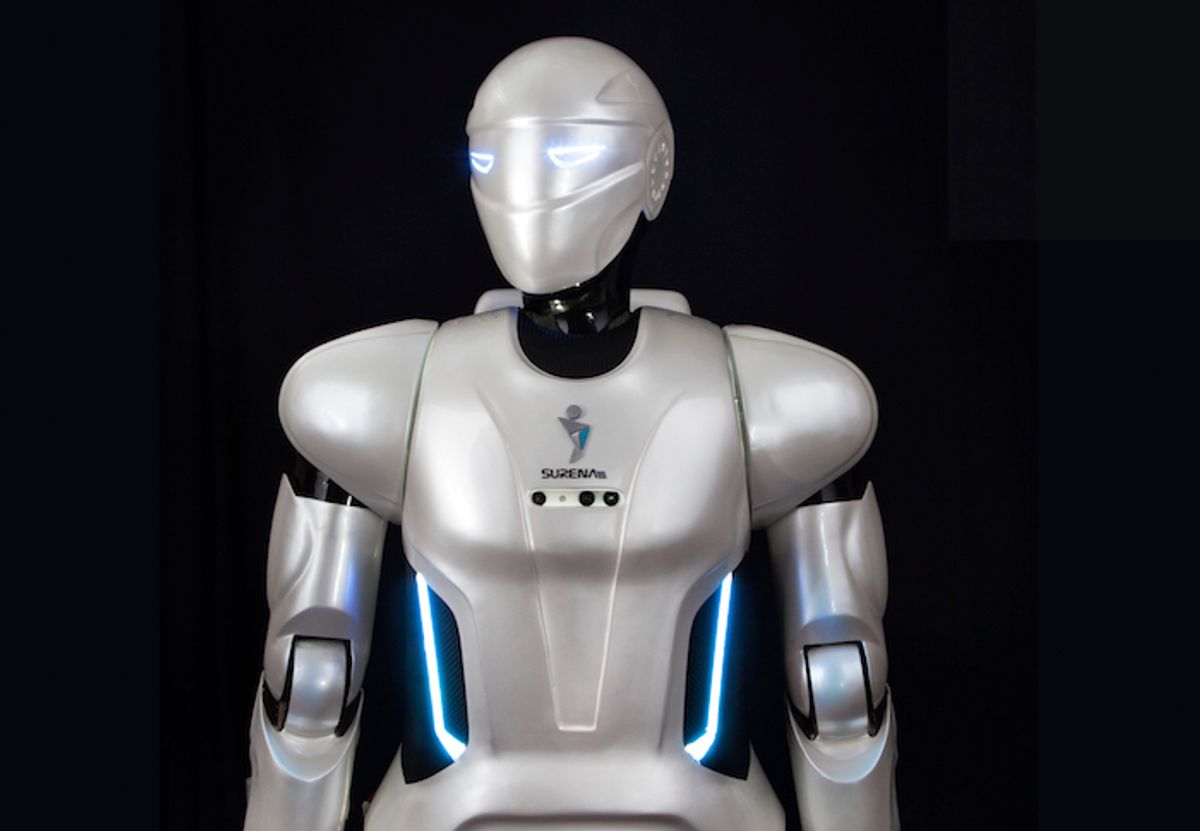Iranian researchers at the University of Tehran unveiled yesterday the latest generation of their humanoid robot, named Surena III. In a demonstration, the adult-size robot walked across a stage, imitated a person’s arm gestures, and stood on one foot while bending backwards.
Dr. Aghil Yousefi-Koma, a professor of mechanical engineering who leads the Surena project, tells IEEE Spectrum that the robot is designed as a research platform to explore bipedal locomotion, human-robot interaction, and other challenges in robotics. He also hopes Surena can help show the importance of engineering careers to students and the public, adding that he views the robot as a symbol of technology advancement “in the direction of peace and humanity.”

With a sleek plastic casing and bright LED eyes, Surena III is 1.9 meters (6 feet 3 inches) tall and weighs in at 98 kilograms (216 lbs). It’s equipped with a host of sensors, including a Kinect-based 3D vision module, and its joints are powered by 31 servomotors. The control software running on the robot and a monitoring system used by human operators to supervise its functions are based on the popular Robot Operating System, or ROS.
Compared to some of the world’s most advanced humanoids, Surena seems to have more limited capabilities. Honda’s famed Asimo can run and hop on one foot, and a new, experimental humanoid the company is developing can even climb a vertical ladder. Several robots that participated in the DARPA Robotics Challenge, a disaster-response competition inspired by the Fukushima nuclear emergency, were able to perform tasks like driving a vehicle, operating power tools, and walking over a pile of bricks.
These robots included Atlas, developed by Boston Dynamics (a company acquired by Alphabet); Carnegie Mellon’s CHIMP; and South Korea’s DRC-HUBO, the winner of the competition.
Surena has yet to demonstrate that level of mobility and dexterity, but the Iranian humanoid has been making steady progress in the past seven years. The first version of the robot, unveiled in 2008, had only 8 degrees of freedom (DOF). Surena II, announced in 2010, had 22 DOF and could walk at a pace of 0.03 meters per second. Now the third generation of the robot has 31 DOF and a walking speed nearly 10 times as fast, at 0.2 m/s.
Professor Yousefi-Koma, who heads University of Tehran’s Center for Advanced Systems and Technologies (CAST), where Surena was developed, says he followed the DRC events and, although Surena was not developed to participate in that competition, “one of the best applications for this robot may be employing it in disasters.”
He says Surena III, funded by the Industrial Development and Renovation Organization of Iran, is currently able to walk up and down stairs and ramps, adapt to irregularities on the ground, grasp objects, and also kick a soccer ball. He sent us footage showing some of those capabilities:
To build Surena III, the Iranian researchers significantly upgraded the robot’s sensors and actuators over the previous version. The vision system now allows the robot to detect faces and objects and track a person’s motions. A speech system can recognize some predefined sentences in Persian. Encoders embedded in all joints, six-axis force/torque sensors in the ankles, and an IMU in the torso help the robot remain stable. To power Surena’s hips and legs, the researchers used a combination of Maxon brushless dc motors, harmonic drives, and timing belt-pulley systems. The upper body uses ROBOTIS Dynamixel AX and MX servos.
The group also completely revamped the software system. It’s now based on ROS, and Professor Yousefi-Koma says it “enables the robot to simultaneously communicate with the environment, manage its behaviors, monitor its sensors, and detect unwanted faults in the system.” A supervisory system with a graphical interface allows the researchers to monitor all joints and sensors, and a SDK with integrated C++ libraries allows them to more easily create and test new behaviors for the robot.

About 70 students, engineers, and professors from Tehran University and five other Iranian institutions helped design and build Surena III. Local companies developing robotics software and speech systems also contributed to the project, and Professor Yousefi-Koma expects that some of the technology developed for the humanoid could find applications in manufacturing, healthcare, and other industries.
He says his group will focus now on the robot’s interactions with humans, and they want to make it more autonomous as well. They’re also preparing papers about the project, hoping to present them at IEEE conferences in the near future. And they are already making plans for Surena IV.
Erico Guizzo is the director of digital innovation at IEEE Spectrum, and cofounder of the IEEE Robots Guide, an award-winning interactive site about robotics. He oversees the operation, integration, and new feature development for all digital properties and platforms, including the Spectrum website, newsletters, CMS, editorial workflow systems, and analytics and AI tools. An IEEE Member, he is an electrical engineer by training and has a master’s degree in science writing from MIT.


